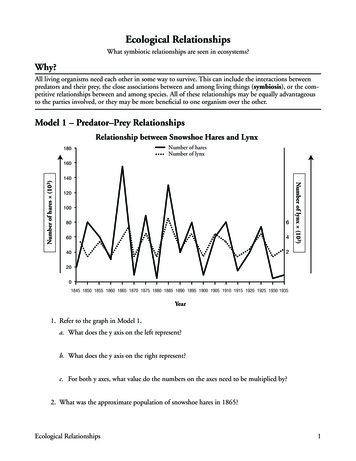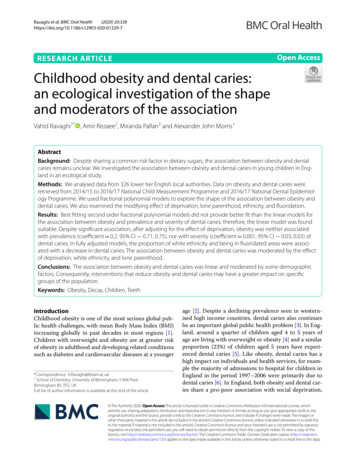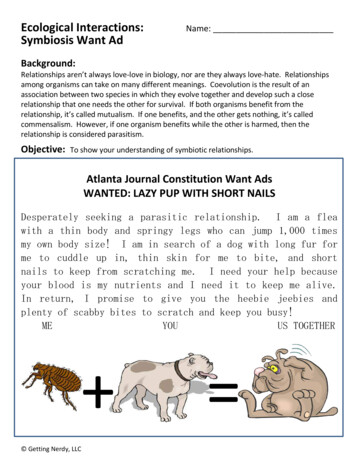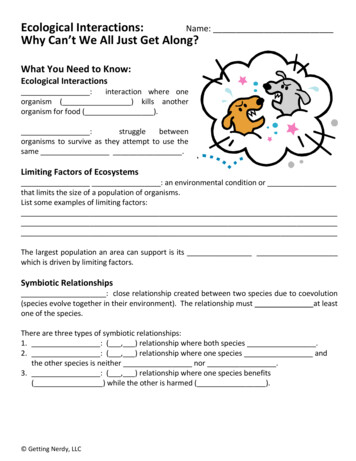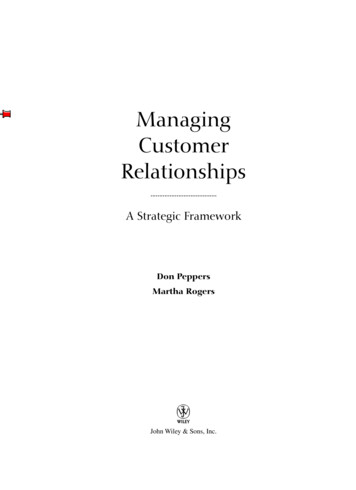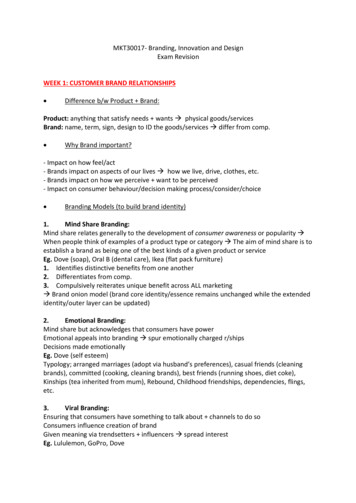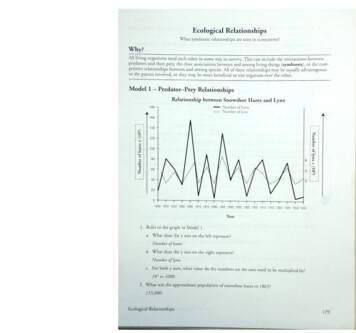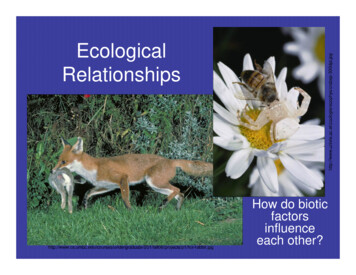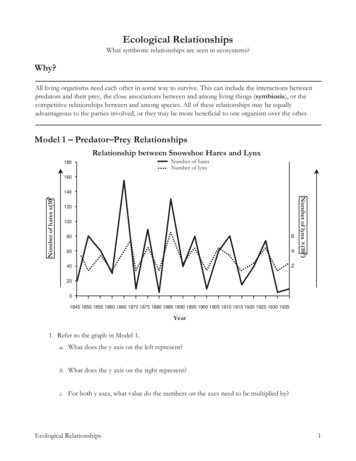
Transcription
Ecological RelationshipsWhat symbiotic relationships are seen in ecosystems?Why?All living organisms need each other in some way to survive. This can include the interactions betweenpredators and their prey, the close associations between and among living things (symbiosis), or thecompetitive relationships between and among species. All of these relationships may be equallyadvantageous to the parties involved, or they may be more beneficial to one organism over the other.Model 1 – Predator–Prey RelationshipsRelationship between Snowshoe Hares and Lynx180Number of haresNumber of lynx160120100806604402Number of lynx (103)Number of hares x(10 31402001845 1850 1855 1860 1865 1870 1875 1880 1885 1890 1895 1900 1905 1910 1915 1920 1925 1930 1935Year1. Refer to the graph in Model 1.a. What does the y axis on the left represent?b. What does the y axis on the right represent?c. For both y axes, what value do the numbers on the axes need to be multiplied by?Ecological Relationships1
2. What was the approximate population of snowshoe hares in 1865?3. What was the approximate population of lynx in 1865?4. When the number of snowshoe hares is high, what happens to the number of lynx? Use actualdata from the graph to support your observation.5. What happens to the population of lynx as the number of snowshoe hares decreases? Use actualdata from the graph to support your observation.6. Propose an explanation for the apparent cause and effect relationship between the populations oflynx and hares.7. What does this information tell youa. about the effect of size of prey populations on the number of predators?b. about the effect of predators on the populations of their prey?8. What other factor would influence the size of the hare population in addition to the size of thepopulation of lynx?2POGIL Activities for High School Biology
Model 2 – SymbiosisSymbiotic RelationshipOrganism 1Organism 2Description of the relationshipDogFleaThe flea feeds on blood from the dog. There isno benefit to the dog and the itching and bitesmay lead to infection.FungusAlgaeThe photosynthetic algae provide food for thefungus, which in turn provides a suitable livingenvironment for the algae.TermiteCellulosedigestingbacteriaThe bacteria in the gut of the termite breakdownand feed on some of the cellulose taken in bythe termite. The termite would be unable todigest cellulose without these bacteria and theygain an additional source of nutrition from thesurplus digested cellulose.SharkRemoraThe Remora fish swim alongside the shark andtake scraps of food that the shark drops duringfeeding. The shark does not eat the Remora andappears unaffected by its presence.CattleCattle egretThe cattle egret follows herds of cattle and eatsthe insects that the cattle stir up as they movethrough the grassland. The cattle appear to beunaffected by the egrets.HumanTapewormThe tapeworm lives in the small intestines whereit feeds and grows, robbing the human ofessential nutrients.9.Refer to the information given in Model 2.a. In the dog and flea relationship, is there a benefit for one of the organisms or for both?b. Is either the dog or the flea harmed by this relationship?c. Which other relationship in Model 2 is similar to that between the dog and flea?10. Refer to the fungus and algae relationship in Model 2.a. Is there a benefit for one of the organisms or for both?b. Is either the fungus or the algae harmed by this relationship?c. Which other relationship in Model 2 is similar to that between the fungus and the algae?Ecological Relationships3
11. Refer to the shark and remora relationship in Model 2.a. In the shark and remora relationship, is there a benefi t for one of the organisms or for both?b. Is either the shark or the remora harmed by this relationship?c. Which other relationship in Model 2 is similar to that between the shark and the remora?Read This!Symbiotic relationships are identifi ed by how they affect the organisms involved. The three types ofsymbiotic relationships are listed below. Mutualism: Both organisms benefi t from the relationship. Parasitism: One organism benefi ts and the other is harmed. Commensalism: One organism benefi ts and there is no effect on the other.12 . Using the information from the Read This! box, label each of the relationships in Model 2 asmutualism, parasitism or commensalism.13. Choose one of the organism pairs from Model 2 and justify why you categorized the relationshipas you did.Model 3 – Inter- and Intra-specific CompetitionGraph AGraph BP. aureliaP. coudatumP. aurelia and P. caudatum grown togetherRelative Population SizeRelative Population SizeP. aurelia and P. caudatum grown separatelyP. aureliaP. coudatum020Number of Days4020Number of DaysPOGIL Activities for High School Biology
Graph CRate of growth of R. tigrina tadpoles in populations of different sizes.1.0Mean Body Mass (g)0.8Minimum mass neededfor metamorphosisto occur.0.65 individuals0.440 individuals0.260 individuals160 individuals012345678910Time (weeks)14. What are the names of the species in graphs A and B in Model 3?15. Which graph shows competition between two different species?16. Which graph in Model 3 shows population growth for only one species?17. What is the difference between the growing conditions in graph A and graph B?18. P. caudatum and P. aurelia are both species of Paramecium, a microscopic protozoan. P. caudatum isthe larger of the two species. When grown separately, which of the two species reaches a largerrelative population size after 20 days?19. When grown separately is there a substantial difference in the relative population size of the twotypes of paramecia after 20 days?20. Compare graphs A and B in Model 3.a. Which population of species of Paramecium is more affected when the two species are growntogether?Ecological Relationships5
b. Considering that P. caudatum is 50% larger in size than P. aurelia, develop a hypothesis withyour group to explain why interspecific competition has an effect on the relativepopulation size of P. caudatum.21. In a grammatically correct sentence, define interspecific competition.22.Refer to graph C in Model 3.a. Describe the species of organism represented by the graph.b. These tadpoles are confined to a limited environment. What are they all competing for inthat environment?23.What is the minimum mean body mass required for metamorphosis of a tadpole to occur?24.When there are only five tadpoles, how long does it take for metamorphosis to occur?25. When the number of individuals is increased to 60, what is the effect on the time takenfor metamorphosis to occur?26. When the number of individuals is increased to 160, what is the effect on the time takenfor metamorphosis to occur?27. Propose an explanation for why the population size affects the number of weeks beforemetamorphosis of the tadpoles occurs.28. The type of competition represented by graph C is referred to as intraspecifi c competition.What is different about this compared to the competition seen in graph B?6POGIL Activities for High School Biology
Extension Question29. An investigation was carried out into competition between two species of grass, Bromus madritensisand B. rigidus. Equal numbers of seeds of B. madritensis were sown in a number of different pots.In each pot, an equal number of seeds of B. rigidus was then sown a different number of daysafter B. madritensis. The results are shown in the graph below.Given that the total dry mass of plant material was the same in each pot, summarize the mainconclusions that can be drawn from this investigation. Suggest an explanation for the resultswhen the delay before sowing B. rigidus was 30 days.10080Percentagecontributions ofB. madritensis tototal dry massafter 45 days60402000102030Delay before planting B. madritensis/daysEcological Relationships7
Ecological Relationships 1 Ecological Relationships What symbiotic relationships are seen in ecosystems? Why? All living organisms need each other in some way to survive. This can include the interactions between predators and their prey, the close associations between and among living things (symbiosis), or the competitive relationships between and among species. All of these relationships
